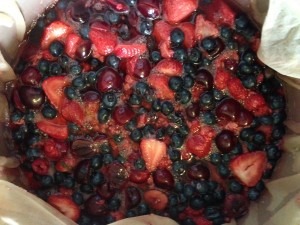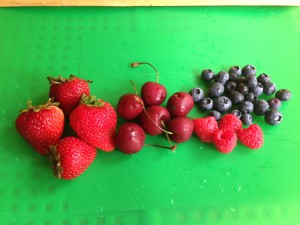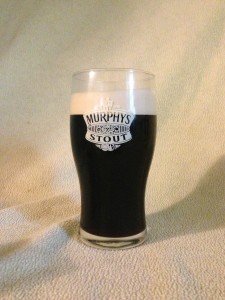[This article is part of a series on brewing with special ingredients. The introduction covered background material and the second installment covered sugars. This is the second part of the installment covering brewing with fruits.]
You will occasionally see old school homebrew recipes call for adding fruit in the boil, or even in the mash. However, your best bet is to add fruit to your beer after primary fermentation.
Adding Fruit in Secondary
The easiest way to do this is to put the fruit — blended, chopped or mushed (or poured right from the can of purée) — in a sanitized fermentation bucket and rack your finished beer on top of it. The sugar in the fruit will fuel a secondary fermentation and the fruit flavors will slowly be extracted from the fruit solids. For most fruits, between one and two weeks of contact time with the fruit should be sufficient. While the secondary fermentation is active, you can open the bucket once a day and punch down the floating fruit into the beer (in the same manner that winemakers punch down the grape solids in a red wine fermentation). Use a large sanitized spoon or potato masher for the punchdown.
Fruit solids generally float, at least early on. If you have a spigot on your bucket, you can transfer the beer out from under the fruit solids when the fruit contact time is done. If you want to further separate the remaining mix of beer and fruit solids, you can pour it into a large funnel lined with a fine mesh bag. Keep in mind, however, that this can oxidize that bit of beer. Try to minimize the amount of beer that gets treated this way. (In general, if you’re making a fruit beer, you have to be willing to lose some beer to being absorbed by the fruit solids.)
You can also add the fruit inside a nylon steeping bag. When the fruit contact time is over, lift the bag and let it drip. Twisting it slightly to press on the fruit will squeeze out more liquid. This will help your yield, but don’t go nuts and squeeze out hazy liquid from the fruit solids.
Sanitation

The alcohol content and low pH of beer will inhibit or kill and contaminating microorganisms on the fruit skin.
The benefit of adding the fruit in secondary, as opposed to the boil, is that volatile aroma compounds will not get boiled off and fruit flavors won’t take on a cooked flavor. (In addition, if the fruit has pectin, it won’t gel from the heat.)
The reason that old school homebrew recipes called for adding the fruit in the boil was sanitation. Fresh fruit harbors wild yeasts and bacteria on its skin and the thought was that those need to be killed or the beer would become contaminated. In practice, when adding fruit in secondary, this doesn’t happen. The alcohol content of the beer and relatively low pH inhibit any microorganisms from the fruit.
If the threat of possible contamination bothers you, stick to using canned fruit purée (which is sterile) or sanitize your fruit with metabisulfite. To do this, blend or mash your fruit into a pulp in your fermentation bucket. Then, add the minimum amount of water it takes to make a thick slurry. Estimate the volume and crush 1 Campden tablet per each gallon (~4 L). Stir this into the fruit slurry and let it sit overnight, with the bucket loosely covered. The next day, rack your beer into the (now sanitized) fruit slurry.
How Much?
So if you’ve decided to make a fruit beer, how much fruit should you add? The answer depends on what fruit you’ve chosen and how strong you want the fruit flavor to be. For a middle-of-the-road fruit intensity, one rule of thumb is to add 1/2 pound per gallon for strongly-flavored fruits (such as raspberries), 1 pound per gallon for medium-intensity fruits (such as sweet cherries) and up to 2 pounds per gallon for mildly-flavored fruits (such as peaches). In metric units, that’s 60 g/L for strongly-flavored fruit, 120 g/L for moderately intense fruit and 240 g/L for mildly-flavored fruit.
Once you’ve decided how much to add, you can calculate how much sugar this will add to your beer by multiplying the ingredient weight by the percentage of sugar in the fruit. (See our fruit composition table for the values for many common fruits.)
Beer Styles
You can add fruit to any beer style you like. However, some styles are better suited than others. For example, hoppy beers aren’t generally made into fruit beers. (Aprihop, by Dogfish Head is one exception, so I’m not saying it can’t be done.) Here are some well-known beer and fruit combinations.
Belgian fruit lambics are classic examples of fruit beers. These sour wheat beers, made with cherries (kriek) or raspberries (framboise) are, arguably, the best-known examples of fruit beers. One of the reasons that fruits work well in sour beers is that the pH of lambics overlaps the pH of most fruit juices. So, when you taste fruit in a lambic, you’re experiencing the fruit flavors with roughly the same amount of tartness the fruit would have by itself. (Also, traditionally, lambic may be sweetened at serving time with a lump of sugar.) Adding fruit to a sour beer is usually done after primary fermentation, just as with “regular” beers. However, the contact time with the fruit is frequently much longer.
Among “regular” (non-sour) beers, wheat beers are frequently chosen as the base for a fruit beer. Either a hefe-weizen or American wheat will pair well with a variety of fruits. Raspberry wheat is a popular homebrew style and American wheat beers can host more mildly-flavored fruits, such as peaches.
The roast-y, sometimes chocolate-like, flavors in a porter or stout can make a good pairing with cherries, raspberries or any fruit strong enough to stand up to the roast in these beers.
Recipe and Brewing Adjustments
Whatever base beer you choose, there a few things you can do to make the fruit flavor stand out. Try to limit the amount of hop aroma or yeast-derived aromas to let the fruit aroma stand out, unless you plan to meld the fruit aroma with either the hop or yeast aroma. Adding a small amount of lactose, an unfermentable sugar, can add a touch of sweetness to your beer and this can enhance the fruit flavor. In general, the more flavor or body the beer has, the more it will conflict with the fruit character. (Fruit lambics, for example, are very dry.) Don’t go overboard with any of these modifications, as you still want the fruit beer to have beer character. However, considering the characteristics of the base beer can help you make small adjustments to your recipe or brewing techniques that will allow the fruit character to better integrate with the beer.



A golden ale also lends itself well to pit fruits (peaches, apricots)
I made a golden with apricots and people clamor for it every year.
Simpler the beer, for me, the more the fruit shines !